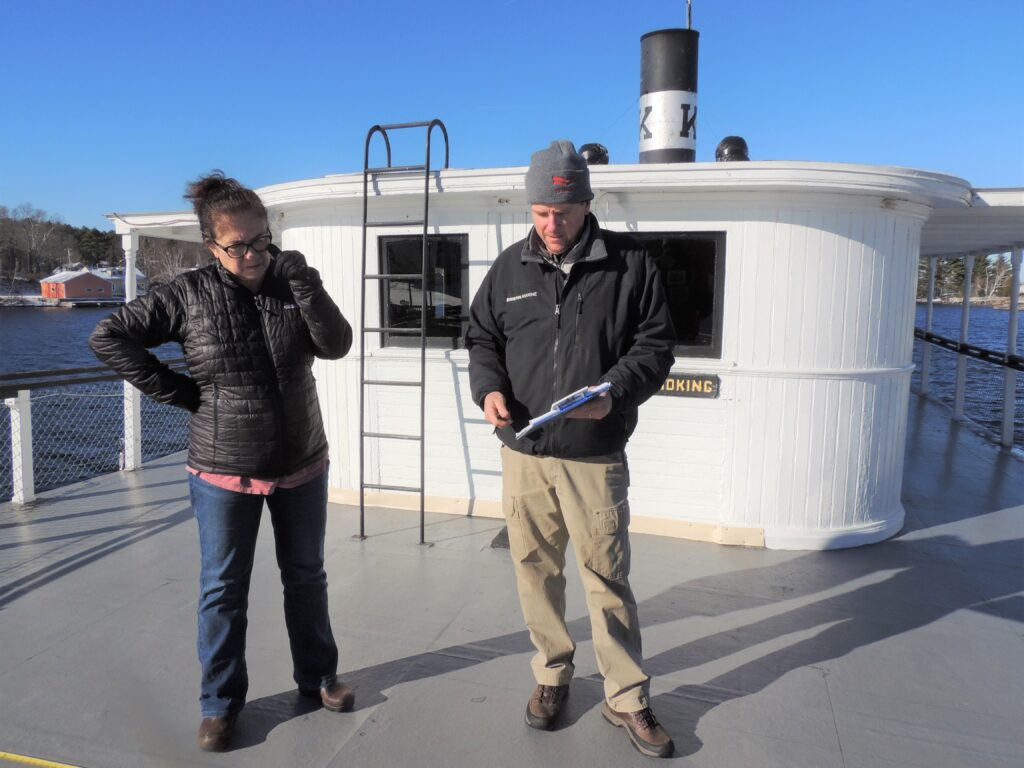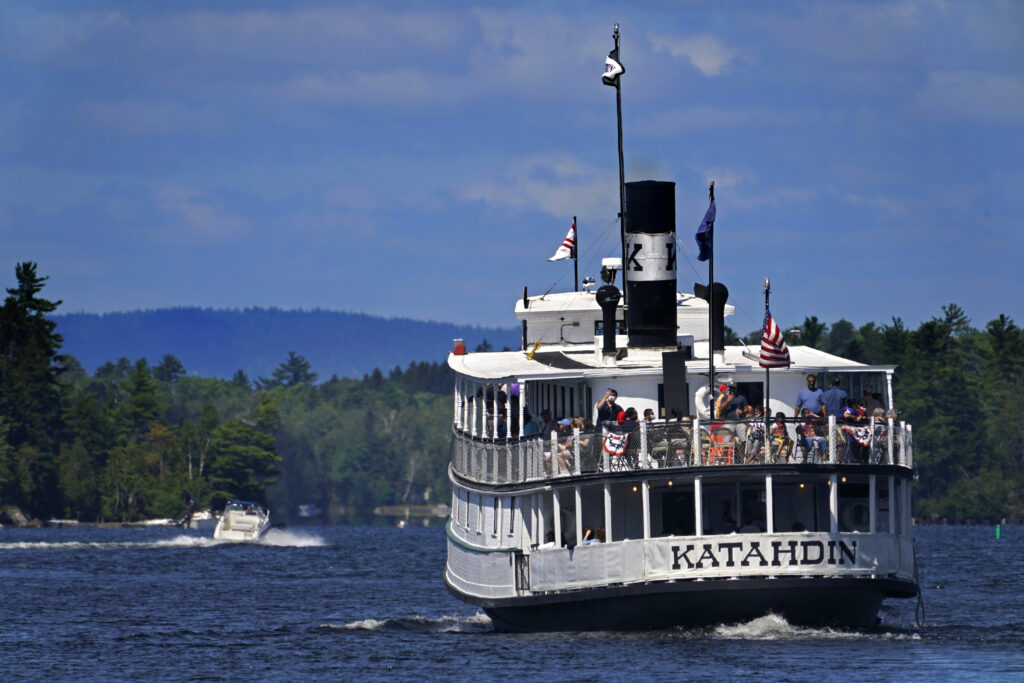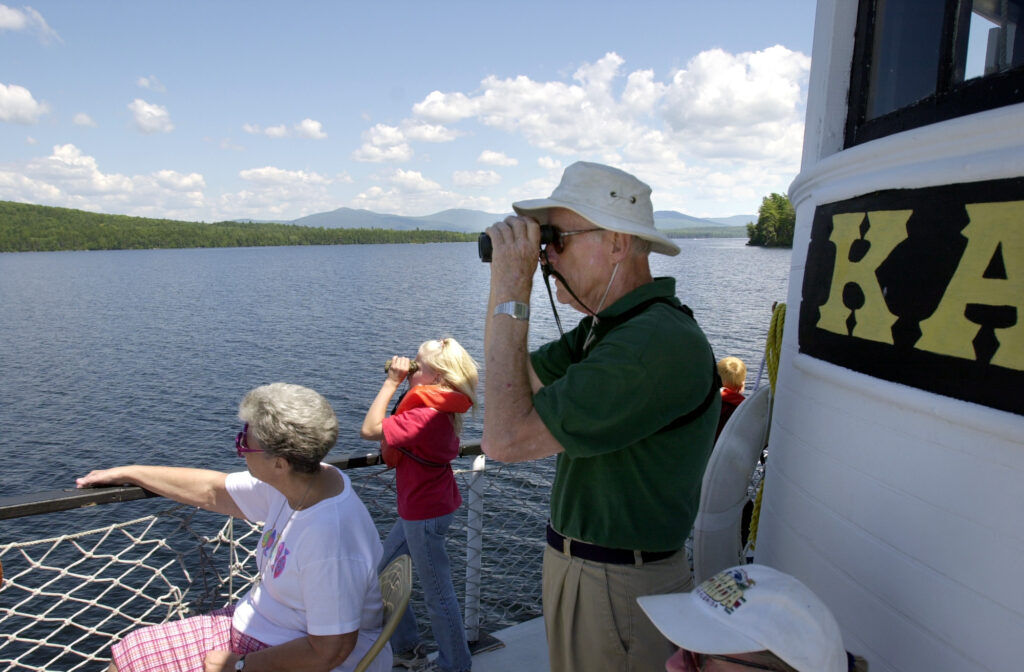
Historic steamboat Katahdin getting 1st major overhaul in years
GREENVILLE — An iconic steamboat built in 1914 — and the oldest Bath Iron Works vessel still operating — is undergoing a number of preservation efforts to ensure it continues cruising Moosehead Lake in the future.
The Katahdin was considered the queen of a fleet of as many as 55 steamboats registered on the lake in the early 20th century and is the only one remaining, according to the Moosehead Marine Museum. It was added to the National Register of Historic Places in 1979.
The steamboat means a great deal to the Moosehead Lake region and Piscataquis County, which rely on roughly 8,000 annual visitors from Maine and beyond who contribute about $1.5 million to the economy, according to the museum. Five years of preservation work, which includes replacing the ship’s decking and structural rail, will help the region draw visitors in the coming decades.

PRESERVATION EFFORTS — Boothbay Harbor Shipyard manager Eric Graves, right, explains measurements part of a steamboat preservation project to Moosehead Marine Museum Executive Director Liz McKeil. The historic Katahdin steamboat is undergoing a number of preservation efforts.
“Our economy, because of the changes in the lumber industry, is almost 100 percent reliant on the tourism industry,” said Liz McKeil, the museum’s executive director. “Anything that brings more people into town is going to benefit everybody.”
The Katahdin and its past also are crucial to education, including as a floating science and history classroom for cruises each fall and to teach more than 250 Piscataquis students about local history, invasive lake species and other topics important to the region.
Preservation efforts began in November and also will include repairs to the steamboat’s hull, propeller and sea chest, a recess in the hull where pipes take in water. The project will be broken into phases and work will take place in the off season, McKeil said.

MOOSEHEAD TOUR — The Steamboat Katahdin makes its way out of Greenville for a tour of Moosehead Lake in this photo from Aug. 15, 2020.
Bristol Marine at the Boothbay Harbor Shipyard — which specializes in mechanical services, metalwork and other repairs for a variety of vessels — will replace the boat’s upper deck. The team will take laser measurements, construct the decking off-site and return to Greenville to install it in the springtime.
Removing the existing upper deck means having to put supports in place, so the process is complicated and requires careful attention, McKeil said. The museum hopes to work with Bath Iron Works on the hull, including sandblasting and painting it, she said.
The structural rail is painted green to distinguish it from the rest of the black and white boat. It is important to be able to quickly identify because it separates the bottom and top structures of the boat, and as it deteriorates, more water can get in and rotting can spread, McKeil said.

DECK VIEW — On the steamboat Katahdin, from right to left, Per Staubo from Connecticut, 8-year-old Barbara Tostantosk from Addison and Rosemarie Danelle from Orono admire views of Moosehead Lake on a three-hour tour in this file photo from July 2001.
It has been 25 years since any major changes have been made to the ship’s decking and rail. It’s possible that the preservation process will reveal more repairs are needed, McKeil said.
“The support for this boat is really good,” she said. “I think people understand how important it is to the region and what a unique and priceless memento it is of an earlier time.”
The Katahdin, also called the Kate, got its start in 1914, hauling mail, people and supplies for Coburn Steamboat Co. It later towed log booms for Hollingsworth Whitney and Scott Paper, according to the museum.
After the last log drive in Maine in 1975, the vessel retired, according to the museum. It was restored and used as an excursion steamboat by the Moosehead Marine Museum in 1986.
The museum hopes to raise $2 million to be used toward preservation work, McKeil said. It has raised about $923,000 from private donors, businesses, foundations and others. The museum also applied for a federal grant worth up to $250,000 through the Institute of Museum and Library Services.
McKeil, whose father was one of the original board members and a former executive director of the museum, looks forward to the project’s completion. It should ensure that the boat won’t have to be repaired again for about 25 years, she said, and the museum can focus on expanding its offerings at that point.
“It’s an extraordinary feeling of everything coming full circle,” she said. “When it’s time for me to pass it on, I want to pass it on better than it was before.”